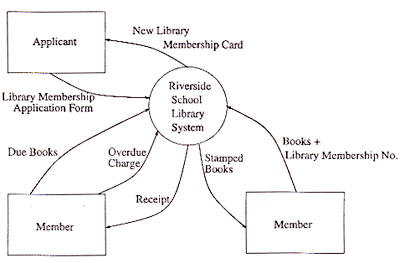| (a) | There are many common reasons for a new system
request, which can be divided into five groups : capability, communication, competitive
advantage, control, and cost. For each of the following requirements, identify the group
in which it belongs: (i) A change in requirements has led management to propose that a new automated system should be developed. (ii) Management requires that a group of functions should be better consolidated through the development of a new system. (iii) The costs for employing human staff has become prohibitively expensive, which has resulted in a manual processing system becoming automated. (iv) Management requires that a networked databases system should be developed to allow for more timely information exchange between its head office and satellite departments. |
|
| (i)
Capabilities. (ii) Control. (iii) Cost. (iv) Communication.
|
||
| (b) | For each of the
following type of cost identify whether it is tangible or intangible: (i) The cost of hardware and software for a new system. (ii) Increased employee fatigue due to use of a new system. |
|
| (i) Tangible. (ii) Intangible.
|
||
| (c) | (i) List two benefits of end-user development. (ii) List two drawbacks of end-user development. |
[2] [2] |
(i)
(ii)
|
||
| (d) | (i) Describe the term Gantt chart. (ii)Draw a simple Gantt chart to represent the time frame to represent the following scenario. A systems development team has been given 16 weeks for fact-finding to gather information for upcoming development. As such, it intends to spend the first 4 weeks to read through documents related to the organization in the 'understanding the organization' phase. The next phase, 'preparation for interviews' will take a further 4 weeks. The 'conducting of interviews' phase is expected to take 3 weeks. The final phase, 'consolidation of results' is expected to take up the final 5 weeks of the fact-finding operation. |
[2] [4] |
| (i) A Gantt chart is a
means of illustrating a each activity involved in the development of a system, as well as
the amount of time each activity will take. (ii)
|
||
| (e) | Draw a context diagram to represent the
following scenario : An applicant becomes a member of the library by submitting a completed membership application form to the library system. A membership card will then be issued. A member can borrow books by presenting his or her membership number. In addition, books are identified by individual book numbers. The books borrowed are stamped with the date by which they should be returned, and passed to the member. The member is required to return by the due date. In the event that the books are returned after the due date, the member will have to pay an overdue charge; in such circumstances, the system will produce a receipt for the member. |
[4] |
|

